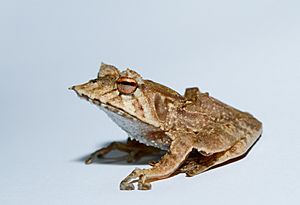Banded horned treefrog facts for kids
Quick facts for kids Banded horned treefrog |
|
|---|---|
 |
|
| Hemiphractus elioti, a frog similar to and once thought to be the same as H. fasciatus | |
| Conservation status | |
| Scientific classification | |
| Synonyms | |
|
Cerathyla fasciata (Peters, 1862) |
The banded horned treefrog, also known as Hemiphractus fasciatus, is a special type of frog. It belongs to a family of frogs called Hemiphractidae. You can find this frog living in the wet forests of northwestern Ecuador. It might also live in the western mountains of Colombia.
This frog used to be thought of as living in Panama. However, scientists later found that those frogs were actually other similar species. These include H. elioti, H. kaylockae, and H. panamensis. The banded horned treefrog is quite large for a frog. It can even bite if it feels threatened!
Contents
What Does It Look Like?
Male banded horned treefrogs can grow up to about 5.6 centimeters (2.2 inches) long. Female frogs are a little bigger, reaching up to 5.9 centimeters (2.3 inches). This measurement is from their snout (nose) to their vent (bottom).
One of the most interesting features of this frog is its head. It has a clear, triangular shape that looks like a "helmet." The frog's back is usually light brown. Sometimes it can be yellowish or grayish. It might also have some darker marks. Its upper legs often have stripes. The underside of the frog is brown. This color gets darker on its throat and chest.
How Does It Reproduce?
These frogs likely breed all year long. When the female lays her eggs, she carries them on her back. She keeps them there until they hatch.
The baby frogs develop directly inside the eggs. This means they do not go through a tadpole stage. Instead, they hatch as tiny, fully formed froglets. They look just like miniature versions of the adult frogs.
How Does It Behave?
Banded horned treefrogs are nocturnal. This means they are active at night. During the day, they usually hide and rest.
If something bothers them, they might make a noise. They also have a special way to defend themselves. They will throw their head back and open their mouth very wide. This shows off their bright yellowish-orange tongue and the inside of their mouth. This sudden display can scare away predators. As mentioned before, they can also bite if they feel they are in danger.
Where Does It Live and How Is It Protected?
The banded horned treefrog lives in very wet places. Its natural habitats include tropical rainforests in lowlands. It also lives in lower mountain forests and cloud forests. These are all very humid and green environments.
Sadly, this frog species is facing some threats. One big problem is habitat loss. This happens when their forest homes are destroyed. Another threat is a harmful fungus called Batrachochytrium dendrobatidis. This fungus can make amphibians sick.
There was a group of these frogs kept at the El Valle Amphibian Conservation Center in Panama. They were being cared for to help protect the species. The plan was to release them back into the wild someday. However, scientists later studied these frogs more closely. In 2018, they found that these frogs were actually H. elioti, a newly described species. Even so, conservation efforts are still very important for all these unique frogs.
See also
 In Spanish: Hemiphractus fasciatus para niños
In Spanish: Hemiphractus fasciatus para niños


